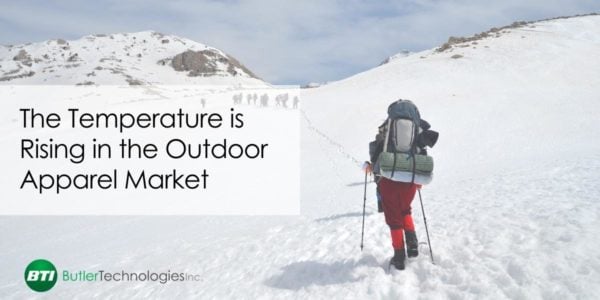The temperature is rising on the flexible heaters market for outdoor enthusiasts and athletes.
Flexible heaters are used across multiple industries – automotive and aerospace, military and defense, safety, and fire service, just to name a few. The flexible heaters market is also growing in popularity with hobbyists, specifically for outdoor recreation, as it provides a new way to stay warm in frigid climates without the bulk and annoyance of wires.
Flexible printed heaters are made by screen printing conductive inks onto flexible materials. These special inks conducts electrical current that produces heat, and by customizing the design and deposition of the inks, we can control the temperature, the surface area, and the run time of the heaters.
With cost-effective materials, an expert design process, and an existing audience base eager to upgrade their apparel and gear, the flexible heaters market is an untapped gem for apparel companies of all shapes and sizes.
Why Apparel Companies Should Keep an Eye on the Flexible Heaters Market
It’s obvious why outdoor recreationists seek out heaters to add to their collection. To stay comfortably warm while camping or hiking, or even to help make exercise more manageable, hobbyists often turn to heated products to provide some warmth. From heated portable camping cots and sleeping bags to heated jackets, gloves, or knee braces, there is a wide breadth of products people can turn to during their adventures.
Apparel companies that already offer traditional wired heaters are in a great position to pivot to wireless, flexible heated technology. The integration is effortless (and easier than integrating a wired element), the cost is low, and there’s already a guaranteed market of consumers.
Alternatively, apparel companies that haven’t considered adding heated elements before are in a better position than ever with a low barrier to entry and an obvious wow factor that’s sure to get your company ahead of the competition in this growing market.
Why Your Customers Want Flexible Heaters
It makes sense that outdoor equipment and apparel expenditure is on the rise, as a growing number of consumers are moving to more comfortable locations while working remotely, taking part in the great resignation, and prioritizing their work-life balance when working from home.
The frequency of leisure trips increased from 11% before the pandemic to 16% after the start of the COVID-19 pandemic, according to a report by Mordor Intelligence. “The situation of COVID-19 had a positive impact on the [outdoor equipment] market growth, as recreationists spent a higher amount of leisure time from their complex work schedules,” the report stated.
Consumers in the market for heated products are looking to stay warm and toasty. However, they’re also likely picky about where and why they spend their money and seek out the best of the best. For example, if you’re an outdoor hobbyist looking to be more comfortable while exploring the great outdoors, wouldn’t choosing a heater with bulky, uncomfortable wires defeat the purpose?
Consumers looking to find heated apparel and outdoor products are likely to seek out ones that lack wires. They also likely don’t want to bother fumbling with the temperature settings constantly, and would rather set it and forget it.
Depending on the specific application, flexible heaters come with external controls that easily fit into the pockets of apparel, so that you don’t have to unzip all your carefully curated layers to check up on your heater’s stats or to edit its settings.
Flexible heater technology makes sense for manufacturers, retailers, and consumers alike. The expanding flexible heaters market is making outdoor recreation more accessible to everyone by making sure hobbyists and explorers can stay warm inside, no matter how cold it is outside.
Flexible Heater Applications for Ourdoor Apparel Companies
The opportunities are endless for implementing flexible heaters into existing products.
At campsites, consumers could use heated sleeping bags, heated blankets, heated tent bases, or heated folding chairs to keep warm.
While on the go, they could utilize heated gloves, heated boots, heated jackets, or heated knee or back braces to stay comfortable or help their muscles during long treks.
Switching from Wired to Non-Wired Heaters
Several companies are already using wired heaters in their materials, demonstrating consumer interest in heated elements on the market. But  traditional wire heaters risk overheating, burning, and even catching fire.
traditional wire heaters risk overheating, burning, and even catching fire.
Innovative, flexible heaters use no wires, but rather use conductive inks and films.
These heaters can safely regulate their temperature via a small external control panel in the case of fixed resistance heaters. The film’s stretch makes it possible to incorporate the heater into performance sportswear such as shirts, pants, or jackets without adding in any bulky, uncomfortable wires.
The Best Type of Flexible Heater for Apparel
There are three types of flexible heaters: fixed resistance, positive temperature coefficient, and Kapton RS.
For apparel, it’s recommended to use a fixed resistance heater on a TPU, as this combination allows for stretching and provides an even level of heat across the material. It’s also simple and cost-effective to produce. This solution uses a small external control pack or battery pack, usually stored in the pocket of clothing, to regulate the temperature.
How Fixed-Resistance Flexible Heaters are Made
First, a protective film of TPU (PolyUrethane) is laid down as a base layer. Then, the resistive element – specialty resistive carbon, silver, or blended ink – is laid down as the heating element. Next, the conductive silver traces & BusBar System are added – these are used to send electricity and heat to the rest of the heater and its conductive ink. Lastly, a top cover layer of TPU film is added to keep all the elements in place and protected. The cover layer can be clear or designed with color/graphics. Hot-melt adhesives are integrated with the TPU for easy application to fabric garments.
Incorporate Flexible Heater Technology into your Next Apparel Product
There’s never been a better time to expand your product offerings or upgrade to a wireless solution for your customers. Adding in or switching to flexible heater technology for your products will keep your company ahead of the curve in this competitive landscape where consumers are prioritizing experiences and seeking out the best of the best.
Butler Technologies, Inc. offers a client-tailored design process and will be there for you through every part of your product’s lifecycle. Our manufacturing facility boasts top-tier screen-printing techniques and a robust network of suppliers, as well as the industry expertise necessary to provide recommendations and keep your projects as cost-effective as possible.
Want to see our products in action? Catch us at the next Outdoor Retailer show, follow along on LinkedIn, or contact us about incorporating flexible heater technology into your next product.
Meet the Author
 Madelyn is an integrated marketing specialist at Butler Technologies and has a passion for problem-solving, project management, and storytelling. She loves marketing in the B2B technology space and has a degree in English specializing in editing, writing and media from Florida State University.
Madelyn is an integrated marketing specialist at Butler Technologies and has a passion for problem-solving, project management, and storytelling. She loves marketing in the B2B technology space and has a degree in English specializing in editing, writing and media from Florida State University.
